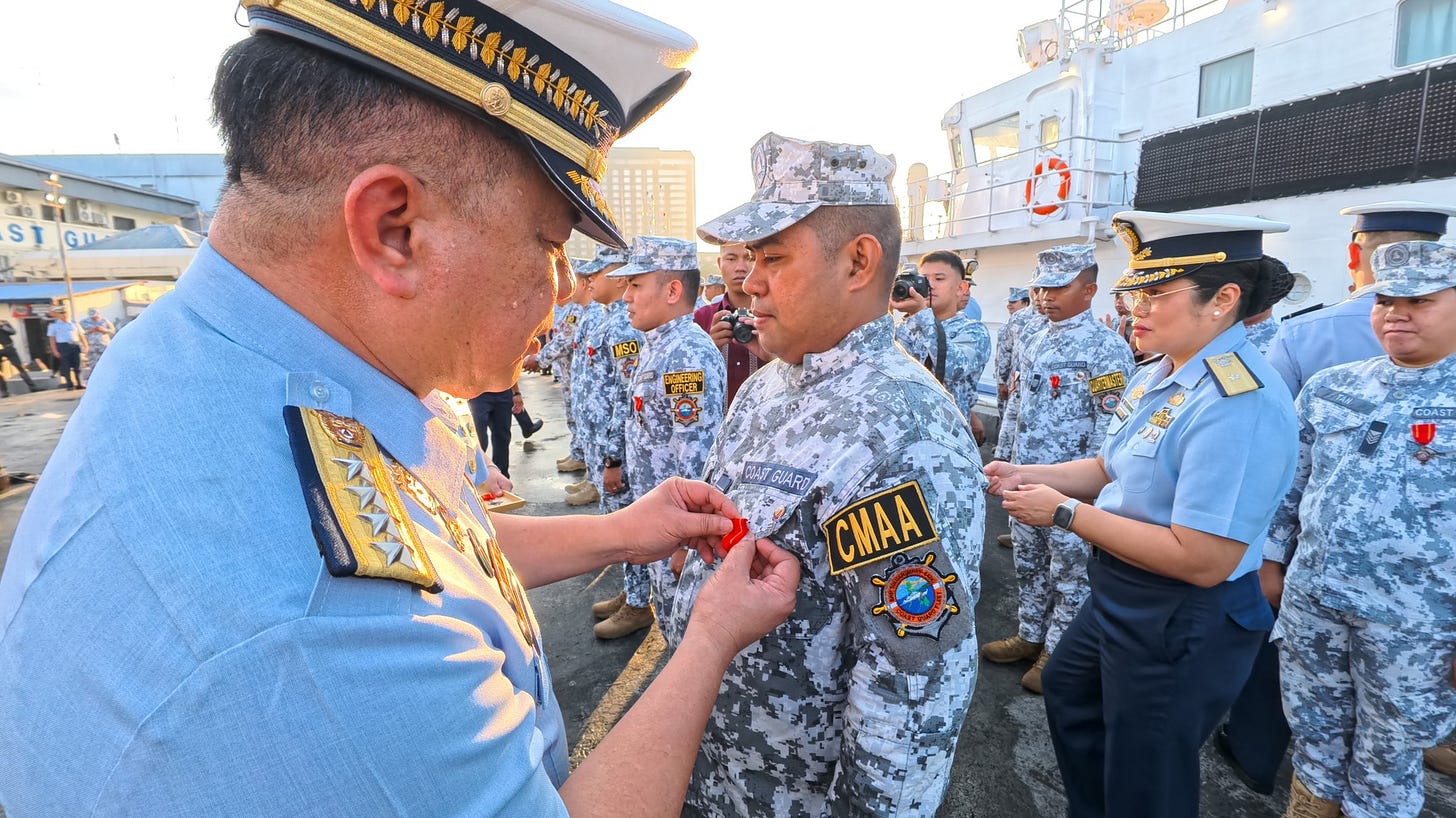The Philippines needs to review and recalibrate its strategy in the West Philippine Sea after the recent collision between two Chinese vessels near Bajo de Masinloc.
China has escalated its actions to illegally, coercively, aggressively, and deceptively assert its sovereignty claim on Bajo de Masinloc after formally submitting its territorial claim to the United Nations.
There are now gray ships present and actively harassing Philippine public vessels.
The Philippines must immediately assess whether it has to send its gray ships in tandem with the Coast Guard to patrol the waters around the contested shoal.
The Philippine Coast Guard vessels currently operate independently from the Philippine Navy to avoid raising tensions in the area.
The Philippines has learned its lesson after China seized control of Bajo de Masinloc in 2012.
Before June 2012, the Philippine Navy used to patrol Bajo de Masinloc, dealing with fishermen from China, Malaysia, and Vietnam poaching within its maritime zone.
In April 2012, the Philippines received reports that several Chinese fishing boats had intruded illegally into the lagoon in Bajo de Masinloc.
Chinese fishermen were harvesting giant clams and could be damaging corals in the area.
BRP Gregorio Del Pilar, an ex-Hamilton-class US Coast Guard cutter, the most capable vessel at that time, was sent to check the situation in Bajo de Masinloc.
From Palawan, where it was stationed, it took only a few hours before BRP Gregorio Del Pilar reached Bajo de Masinloc.
It caught the Chinese fishermen red-handed gathering giant clams in Bajo de Masinloc, but before BRP Gregorio del Pilar could tow the Chinese fishing boats back to Subic Bay, several Chinese Coast Guard showed up and prevented the arrest of the Chinese fishermen.
The Philippine Navy found itself in a dilemma. It cannot confront Chinese white ships with a gray ship.
Thus, the Philippine Coast Guard came to the rescue, rushing to the area and holding the Chinese Coast Guard to a stand-off for three months until Washington brokered a deal between Manila and Beijing for the two sides to withdraw from the shoal to defuse tension.
Truth matters. Quality journalism costs.
Your subscription to Mencari (Australia) directly funds the investigative reporting our democracy needs. For less than a coffee per week, you enable our journalists to uncover stories that powerful interests would rather keep hidden. There is no corporate influence involved. No compromises. Just honest journalism when we need it most.
Manila complied but Beijing did not honor the deal. From then on, the Philippines sends its Coast Guard to Bajo de Masinloc to honor the deal to deploy only white ships in the area.
The Philippine Navy also patrols the area from a distance, conducting freedom of navigation patrols within its exclusive economic zone.
China has again violated the 2012 agreement by deploying gray ships in Bajo de Masinloc. Worse, the Chinese Navy has been actively involved in driving Philippine public vessels in the area.
The latest Chinese vessel collision incident had demonstrated China’s gray ship operations in the area.
The Luda-class guided-missile destroyer (CNS 164) was determined to ram and damage the smaller Philippine Coast Guard’s multi-role response vessel (MRRV-4406), BRP Suluan.
However, the Chinese destroyer collided with a Chinese Coast Guard cutter when it sliced through the path of the two white ships.
The collision showed only one thing: the Chinese Navy lacks professionalism and maritime skills, which could be dangerous to other states.
A Philippine Navy flag officer predicted more potential accidents in the West Philippine Sea as long as China continues its “illegal, coercive, aggressive, and deceptive” (ICAD) operations in the West Philippine Sea.
Rear Admiral Roy Vincent Trinidad said Beijing has shifted away from “gray zone” tactics to a more dangerous ICAD.
What can the Philippines do?
The Philippines has many options to deal with China’s ICAD operations. First, the Philippine Navy could increase its presence and activities in the West Philippine Sea by working in tandem with the Philippine Coast Guard.
When conducting FONOPs in the South China Sea, the US Navy carrier group is usually joined by a US Coast Guard vessel.
There had also been a joint sail between the US and the Philippines where Coast Guard vessels were asked to join a purely military activity.
Thus, it is prudent for the Philippine Navy and Coast Guard to operate together in the West Philippine Sea.
The Philippines can also increase its presence in disputed features, like Bajo de Masinloc, Ayungin Shoal, and the Reed Bank to protect the country’s interests.
Both the Navy and Coast Guard now have better platforms with longer endurance and range. For instance, the Philippine Navy has three guided-missile frigates that can patrol disputed waters for three to four weeks without replenishment.
Meanwhile, the Coast Guard has two 97-meter vessels that are capable of matching the endurance of the Navy’s frigates.
“Showing the flag” constantly in the contested features would reinforce the Philippines’ assertion of sovereign rights in the area.
Moreover, the Philippines should frequently hold joint sail with like-minded countries, such as Australia, Canada, the European states, India, Japan, New Zealand, and the United States.
The Philippines is in a better position now to assert its sovereignty and sovereign rights. It should not be cowed to bow down to China’s wishes.
The Philippines must take back control of Bajo de Masinloc. Not by force, but diplomatic and political means.
The opinions expressed are those of the author and do not necessarily represent the views of this publication.
Got a News Tip?
Contact our editor via Proton Mail encrypted, X Direct Message, LinkedIn, or email. You can securely message him on Signal by using his username, Miko Santos.
Sustaining Mencari Requires Your Support
Independent journalism costs money. Help us continue delivering in-depth investigations and unfiltered commentary on the world's real stories. Your financial contribution enables thorough investigative work and thoughtful analysis, all supported by a dedicated community committed to accuracy and transparency.
Subscribe today to unlock our full archive of investigative reporting and fearless analysis. Subscribing to independent media outlets represents more than just information consumption—it embodies a commitment to factual reporting.
Not ready to be paid subscribe, but appreciate the newsletter ? Grab us a beer or snag the exclusive ad spot at the top of next week's newsletter.









